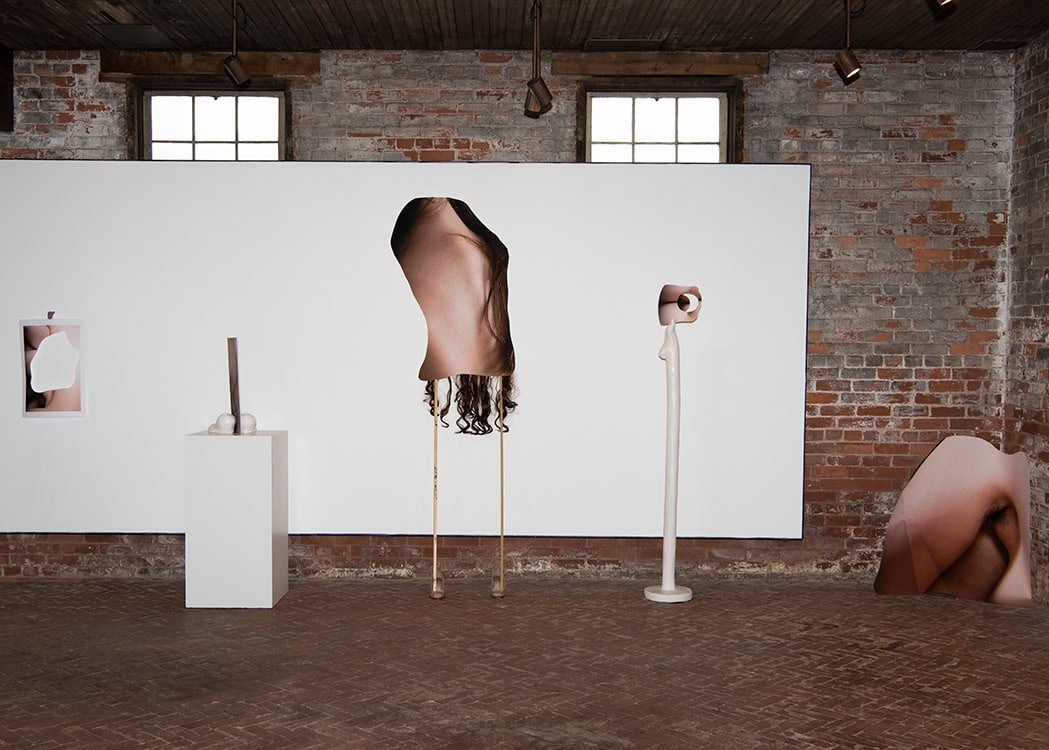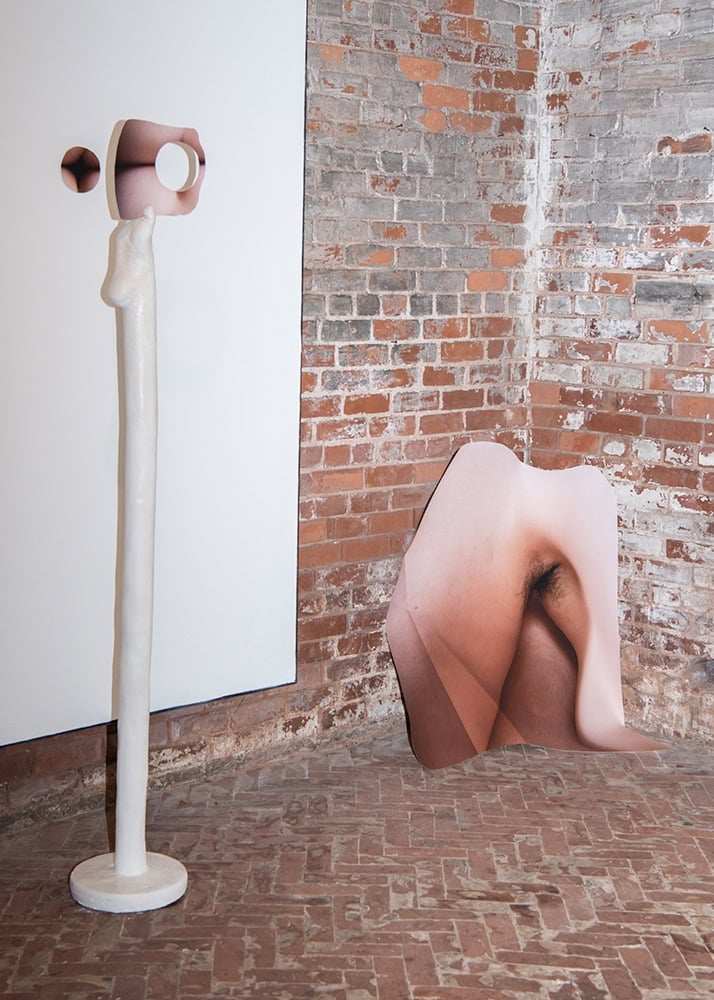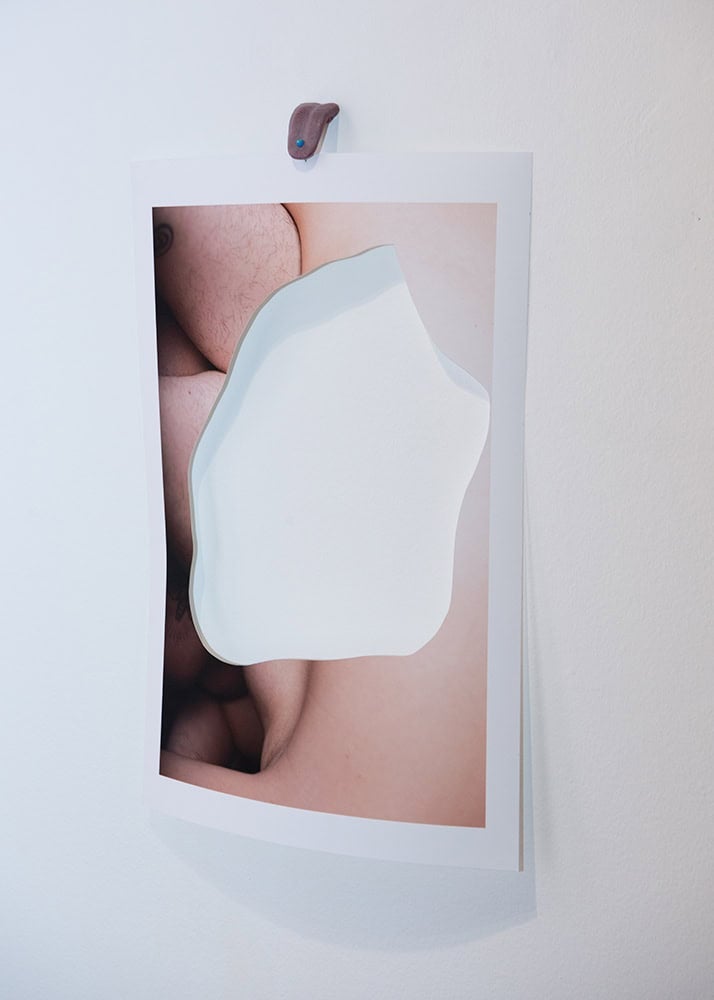
A soft parcel of white flesh perches in the corner of the renovated carriage house containing the Atlanta gallery Whitespace. Its curved back leans against the brick wall; in repose, its curled and tucked parts allow a small patch of downy black hair to scrawl outward, as if to mark itself human and present.
Parker Thornton’s Slump does exactly as its name suggests. The photograph, which has the dimensions of a small child and has been cut into an amorphous shape suggesting a crouching human body, punctuates the presentation of Thornton’s photo-based installations in Whitespace’s most recent group show, On Singing the Body Formless and Electric.
Curated by Lisa Alembik, the exhibition featured eight other artists in addition to Thornton: Hannah Adair, Eleanor Aldrich, Catherine Lucky Chang, Hannah Ehrlich, Larkin Ford, Joe Hadden, Carrie Hawks, and Michelle Laxalt. Across mediums including painting, ceramics, and video, each artist’s work probes themes related to the corporeal and ephemeral experiences of the body. Some artists, such as Thornton, examine the body—particularly feminine-presenting bodies—entirely through form.
Selected from an ongoing series called Skins, the five works by Thornton in the exhibition are subtractive in nature, dealing with neither the body’s generative nor responsive qualities, focusing instead on the formal possibilities of the flesh. Seemingly unconcerned with the body as it experiences physical limitations and three-dimensional boundaries, Thornton’s works stretch, pull, curve, and seep into the space beyond their edges.
In the final stanza of Walt Whitman’s 1855 poem “I Sing the Body Electric,” the poet’s praise-song catalogues specific parts of the body—“Head, neck, hair, ears, drop and tympan of the ears”—moving from the top of the head, down the torso, along the legs and hips, and finally down to the heels. As the lines of Whitman’s poem move down the human form, he injects newly invented phrases into his descriptions to eulogize the body, inventing his own vocabulary to talk about body parts which, although obviously not unique, he regards as wondrous curiosities.

“Eye-fringes,” “jaw-hinges,” “neck-slue,” “hind-shoulders,” “man-root,” and “lung-sponges” join together to reimagine the body as a mass of strange, incredible parts. In the final lines of the poem, Whitman puts the flesh into action, laying bare the glory and grace of an embrace, a curved arm, a body swimming and laughing.
The curious sympathy one feels when feeling with the hand the naked meat of the body,
ADVERTISEMENTThe circling rivers the breath, and breathing it in and out,
The beauty of the waist, and thence of the hips, and thence downward toward the knees,
The thin red jellies within you or within me, the bones and the marrow in the bones,
The exquisite realization of health;
O I say these are not the parts and poems of the body only, but of the soul,
O I say now these are the soul!
Where Whitman uses language to closely examine the body in its discrete parts and composite form, in motion and at rest, Thornton creates her own visual vocabulary using manipulated photos of bodies and sculptural plaster limbs to explore the physical body as raw material. Dispassionate and passive, Thornton’s bodies evoke feelings of both disgust and sensuality.

At the opposite end of the wall from Slump, Slip hangs from a brown synthetic tongue. The photograph, which features a large cut-out portion in the center, is suspended by a blue stud piercing the center of the tongue, causing the image to protrude convexly as the edges of the photo curve backward and hug the white wall. The fraction of the image remaining shows a hairy, tattooed limb pressed against smooth skin. The dark meeting points between the skin are interrupted by the cut-out chasm at the center, where shadows from the gallery lights create a depth that suggests a falling-away of some part of the body, or bodies.
In Eclipse, Thornton obscures her forms even further. At the end of an elongated, sculptural white leg, a photo with curved cut edges sits between the curled toes of a plaster foot. Again, the subject of the image is only identifiable by the darkened meeting places between folds of skin, and, again, a large cut-out in the center of the image obliterates the viewer’s ability to grasp any content within the photo. Eclipse is the closest Thornton comes to singing the body electric via her sliced and re-composed forms. Although utterly static, the installation demands motion from the body of the viewer. Rather than eliminating the cut-out circle entirely from its original image, the cut-out portion is installed on the wall directly behind the plaster limb. If the viewer moves around the work in just the right way, changes in her perspective allow the circle to move back and forth through the cut-out, eclipsing the two-dimensional flesh into itself within a three- and four-dimensional space.
While Thornton’s works are undoubtedly focused on form, the five works displayed in On Singing the Body Formless and Electric are acutely attuned to the body’s malleability. Like Whitman, who broke bodies down into disparate parts to caress them with new names, Thornton edits and reframes the body through photography and sculpture, confronting its strange and disorienting sensuality.
Works by Parker Thornton were on view in the group exhibition On Singing the Body Formless and Electric at Whitespace in Atlanta from August 2 through September 1.




